- Italy Tours Home
- Italy Ethos
- Tours 2023
- Blog
- Contact Us
- Dolomites
- Top 10 Dolomites
- Veneto
- Dolomites Geology
- Dolomiti Bellunesi
- Cortina
- Cadore
- Belluno
- Cansiglio
- Carso
- Carnia
- Sauris
- Friuli
- Trentino
- Ethnographic Museums
- Monte Baldo
- South Tyrol
- Alta Pusteria
- Dobbiaco
- Emilia-Romagna
- Aosta Valley
- Cinque Terre
- Portofino
- Northern Apennines
- Southern Apennines
- Italian Botanical Gardens
- Padua Botanical Garden
- Orchids of Italy
The Cansiglio Plateau: an Example of Ancient Managed Forest in the Venetian Pre-alps.
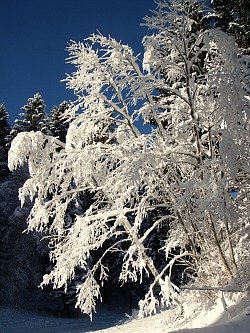
The Cansiglio is the Second Largest Natural Forest in Italy
With its extensive 7,000 ha of Beech and Fir, the Cansiglio forest is the second largest in Italy.
Its impressive extension will strike you immediately for its apparent uniformity, which is in fact deceptive, as it conceals many differences and peculiarities.
There are two most common accesses to the area: if you take the beautiful winding road up from then Venetian plain – through Vittorio Veneto and Fregona – you will meander first through a thick, lush beech forest, signaling oceanic and humid weather conditions, before dropping into the plateau after Passo Crosetta (1,176 m).
On the other hand, the approach to Cansiglio from Alpago will see you cross a large extent of impressive conifer woodland – a reminder of more continental weather conditions.
In either case, there comes a point at which the forest ends, and you are left with the unhindered view of an undulated, seemingly infinite open meadow.
This is the Cansiglio plateau, and its first sight cannot be easily forgotten, as it is an almost magical vision. While in summer it is a verdant area of pastures and woodland – also due to its high rainfall levels (see the first picture below), in winter the Cansiglio turns into one of the coldest corners of the entire Alps – and that's when it really looks like a small Scandinavia! (the second image shows a winter view of the plateau, as it is approached from the south).
General characteristics
The Cansiglio is a karstic area that dominates the Venetian plains, and its conformation is like a ‘bowl’ of elliptical shape, at whose center is a plateau at an average altitude of about 1,000 m above sea level. Over the plateau, a great number of sink-holes and dolines of karstic origin are visible. The noteworthy accumulation of impermeable material at the bottom of the dolines – just like the clay deriving from the disintegration of the ‘scaglia’ – can transform them into small pools locally known as ‘lame’.
An important aspect that characterises and differentiates the Cansiglio from the surrounding areas – such as Alpago – is its peculiar climate. Precisely for its conformation – shaped like a ‘bowl’ – from the internal slopes of the plateau descend cold and heavy air currents that will then stagnate in the central basin (this phenomenon is known as ‘thermal inversion’). These climatic variations also influence, in turn, the vegetation, which is modified in its succession. In fact, in the lower altitude band, one can find pastures and meadows, normally present only at higher levels, followed by conifer woodland (even though the latter are mostly the result of spruce plantations of artificial nature), to then finish with montane beech wood higher up, in the altitude band comprised between 1,050 and 1,400 meters above sea level.
Flora
The forest is mostly composed of pure Beech, with columnar plants of majestic bearing that sometimes reach 30 m in height. Relatively rare is Silver Fir (Abies alba), less so Norway Spruce (Picea abies) – simply because the latter is mostly the result of artificial plantations. Precisely for the beauty of the beech forest present here – mostly due to genetic selection of the best specimens – seeds are being collected in the forest, stored and replanted by the ‘Corpo Forestale dello Stato’. Besides, these majestic plants were historically used by the Republic of Venice in order to craft oars for its powerful fleet. The Cimbri – called here by the Arsenal of Venice during the 1700s – made a particularly meaningful contribution to such activity.
The other plant species present in the undergrowth include Raspberry (Rubus idaeus), Herb Paris (Paris quadrifolia), Purple Mountain Lettuce (Prenanthes purpurea), various Ferns, Green Hellebore (Helleborus viridis), Mezereon (Daphne mezereum) and the Windflower Anemone nemorosa, besides various types of mushrooms and lichens. Along the route, one can observe several fenced areas, which are part of the project CONECO-FOR – the National Network for the Control of the Forest Ecosystems, instituted in 1995 by the Italian Forestry Commission. This is a system that allows to assess the state of health of these woodlands. Among the surveys that were executed here, of major relevance is the monitoring of the rainfall amounts, of plant chemistry and the leaves’ structure, of the soil composition, with the goal to individuate the more harmful elements present in the atmospheric pollution for the woodlands (a more detailed description of the LIFE+ManFor trail can be seen on a dedicated page, Cansiglio LIFE Project).
Fauna
Thanks to the interdiction to hunting for over a century, the Cansiglio forest presents a rich and interesting fauna. Amongst the large herbivore mammals one can admire Red Deer (Cervus elaphus, present in large numbers) and Roe-deer (Capreolus capreolus), as well as Fallow Deer (Dama dama) – the latter a species introduced by man. Other mammals present in the area include: European Hare (Lepus europaeus), Fox (Vulpes vulpes), Badger (Meles meles), European Polecat (Mustela putorius), Least Weasel (Mustela nivalis), European Pine Marten (Martes martes), Beech Marten (Martes foina), Eurasian Red Squirrel (Sciurus vulgaris) and Fat Dormouse (Glis glis). In the past, there have also been reports of large predators such as Brown Bear (Ursus arctos) and Eurasian Lynx (Lynx lynx), which – however – must be considered occasional sightings.
There are many species of passing, migratory and non-migratory birds too: amongst the first category, we can mention (in the ‘lame’): Mallard (Anas platyrhynchos), Garganey (Anas querquedula), Grey Heron (Ardea cinerea) and occasionally Black Stork (Ciconia nigra); amongst the two latter categories are Eurasian Woodcock (Scolopax rusticola), Song Thrush (Turdus philomelos), Fieldfare (Turdus pilaris), Common Blackbird (Turdus merula), Barn Swallow (Hirundo rustica), European Robin (Erithacus rubecula), Common Starling (Sturnus vulgaris), Two-barred Crossbill (Loxia leucoptera; occasional) and the rarer Western Capercaille (Tetrao urogallus) and Black Grouse (Tetrao tetrix), plus several species of Tit and Finch.
Amongst the diurnal raptors, one can count Common Buzzard (Buteo buteo), Eurasian Sparrowhawk (Accipiter nisus), Northern Goshawk (Accipiter gentilis), Common Kestrel (Falco tinnunculus), Black Kite (Milvus migrans) and Red-footed Falcon (Falco vespertinus), while amongst the nocturnal raptors are Eurasian Eagle-owl (Bubo bubo), Long-eared Owl (Asio otus), Eurasian Pygmy Owl (Glaucidium passerinum), Tengmalm’s Owl (Aegolius funereus), European Scops Owl (Otus scops), Barn Owl (Tyto alba) and Tawny Owl (Strix aluco). Rarely it is also possible to spot the majestic Golden Eagle (Aquila chrysaetos), which nests on nearby Monte Cavallo (2,250 m).
Amongst the reptiles are Viper (Vipera aspis and V. berus), Green Whip Snake (Hierophis viridiflavus), Grass Snake (Natrix natrix) and the Italian Slow Worm (Anguis veronensis). Amongst the amphibians, in the proximity of the ‘lame’ one can spot Fire Salamander (Salamandra salamandra), European Toad (Bufo bufo), Alpine Newt (Ichthyosaura alpestris) and Northern Crested Newt (Triturus cristatus).
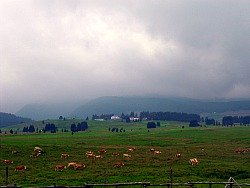
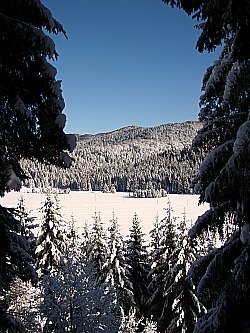
In fact, the way in which the vegetation is distributed is an indication of the peculiar micro-climatic conditions over the plateau.
The most unusual thing to notice is that the conifer forest lies all around the edge of the vast open meadow, while Beech and other broad-leaved species cover the mountain tops, at higher altitudes (they are usually found at lower levels).
This peculiar phenomenon of thermal inversion is due to micro-climatic factors: the plateau – being like a vast basin surrounded by higher mountains – causes heavy cold air to stagnate, making it a lot colder at lower levels than higher up.
This explains why the vegetation bands are also unusually inverted – and this is just one of the many natural features that make Cansiglio one of the most peculiar micro-regions within the Italian Alps. The area is noticeable also for its Alpine flora; were it not for the ascent, in fact, you could easily forget that you are at an average altitude of around 1,000 metres, as the plateau – and the name of course aptly suggests it – looks almost flat, surrounded by low, rounded mountain tops at an average height of 1,500/1,600 metres.
Only looking further afield, the higher, jagged peaks of Alpago – closing the distant horizon to the north – will remind you that this is a mountainous region after all (an image of the plateau follows, looking towards the north, with the mountains of Alpago in the background).
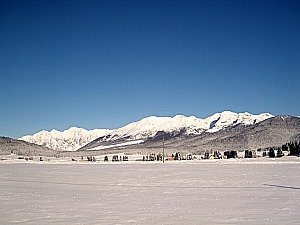
The Cansiglio and its Karstic Phenomena
As a matter of fact, though, at closer examination the plateau is all but flat, peppered as it is with caves and sink-holes that are the most direct reminder of its karstic nature, as the Cansiglio is formed mainly of sedimentary rocks, which have facilitated the formation of characteristic karstic phenomena.
Perhaps, the most famous local karstic features are two caves: Bus de la Lum (literally, “The Hole of the Light”) and Bus della Genziana (“The Gentian Hole”) – which at a depth of 582 m is actually the most profound sink-hole in the area, hosting also a population of rare insects.
These cavities are part of a complex subterranean water system, which can be best appreciated at the foothills of Cansiglio – especially at the Livenza Springs (Sorgenti della Livenza), where incredibly clear water springs almost magically out of the living rock.
The Bus de la Lum, with a depth of 158 m, is not the deepest but certainly one of the eeriest of these karstic features, with legends and macabre facts of history associated with it.
The name is said to derive from the sight of halos emanating from the cavity, especially at night – the presence of ghosts say some, but the phenomenon is more likely to be due to the rotting carcasses of animals that have fallen into the hole.
Whether that’s a legend or not, however, there’s no escaping from the more somber reality of many civilians that were actually thrown into the sink-hole during the atrocities of Second World War.
Luckily, though, today the plateau strikes again for the wide serenity of its open landscape – and there’s certainly a lot here to provide interest for the casual walker as well as for the more scientifically oriented wanderer.
Right in the middle of the plateau is nestled the interesting Cansiglio Botanic Garden; nearby is also a small Natural History Museum (below, another image of the plateau in winter, close to the Botanic Garden).
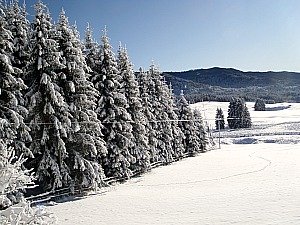
When walking around the gently twisting roads that take you high in altitude, you may stop and wonder at the straight, tall trees whose ancestors are responsible for the fortunes of the magical city that looms in the distance from the mountain tops on clear days: Venice.
The Republic of Venice confiscated the so-called “Bosco d’Alpago” – as the Cansiglio forest was then called – in 1547, about a century after annexing the surrounding territories, and always managed these woodlands wisely.
In fact, this forest used to be also known as “Gran Bosco da Reme di San Marco” (‘remo’: oar) – a name that makes a clear reference to the fact that the government of the Republic of Venice (then called “La Serenissima” – “The Most Serene Republic”) obtained from here the wood it needed for its naval fleet, as well as the building material for the foundations of its many ‘palazzi’.
One could quite rightly say that this woodland is in fact one of the first examples of a managed forest, as Venice needed to make sure of having a plentiful supply of wood without depleting the source – while also keeping a friendly relationship with the local population, therefore allowing the locals a number of benefits (such as a certain ratio of wood use).
Still today, the woods are property of the Italian Forestry Commission, and are managed through Veneto Agricoltura following a detailed plan, in combination with cattle farming.
While in the fields the animals roam freely, the milk produced is collected by a Co-operative dairy that gathers all farmers throughout the plateau.
The Cimbri of Cansiglio: an Old Civilization
As well as a compelling nature, the Cansiglio has also an interesting story to tell. The plateau was once inhabited by the Cimbri – a nomad population of German origin that established itself in the area during the 18th century, coming mainly from nearby Altopiano di Asiago.
They were hunter-gatherers, and had a semi-tribal way of life. They used to build their dwellings entirely in wood; in fact, woodwork was their main skill, and their ways to make a living included charcoal production, the fashioning of boxes (they were literally known as “Cimbri scatoleri” – ‘box makers’) and the making of wooden tiles used as roof cover (locally known as ‘scandole’).
Unusually for this area, their dwellings were also built entirely in wood, and the typical Cimbrian house was then known as ‘Huta’ – a name clearly showing their German background (the same word would be ‘Hütte’ in modern German).
The descendants of the Cimbri – albeit not very numerous – still live scattered in the villages around the plateau today, but the fact that they were not sedentary means that there is very little left in the way of architecture.
Perhaps, the most striking places to visit in order to acknowledge oneself with this old and fascinating population are the villages of Vallorch (portrayed in the picture below), Pian Canaie, Le Rotte and Canaje Vecio.
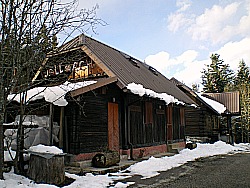
Most of these villages were destroyed during World War II hostilities, but at Vallorch one can still admire some wooden huts, reconstructed with the traditional techniques (one of them is still lived in!). There is also a bar/restaurant lodged in an old Cimbrian hut, so that you can enter and explore for yourself.
Pian Canaie strikes instead as a haunting witness of the past – a ghost village in the middle of the forest, where only the sediments of old homes remain (a ‘Huta’ has recently been rebuilt for demonstrative purposes, and it is pictured below, showing clearly the ancient building technique known as Blockbau).
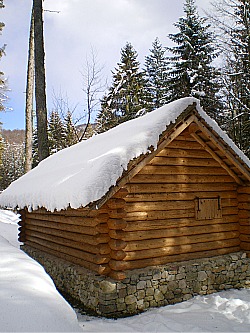
However, if you want to acknowledge yourself more with the culture of this old civilization, a stop at the “Museo Etnografico della Civiltà Cimbra” (Ethnographic Museum of the Cimbrian Civilization) is a worthwhile visit.
Situated at Pian Osteria (one of the former Cimbran villages), there you will find also an interesting documentation on the history of the forest, with archaeological finds and other artifacts on display.
In any event, despite being scattered, what is left of the Cimbri is still a vibrant community, able to organize a popular event that takes place every year at Pian Osteria in August.
The Cansiglio Still Looks Like an Untamed Forest
All in all, then, it is quite clear that Cansiglio provides interest on many different levels, from a naturalistic as well as from an historical point of view.
But perhaps, the single best piece of information to bear in mind is that although this area still looks today like a relatively vast expanse of untamed forest, this sight is in fact deceptive. Even though it is true that it is possible to roam for hours without encountering many traces of human presence (despite being only an hour’s drive away from the hustle and bustle of Venice), it is also a fact that what we see today is the product of a very careful management – so, in that sense, it is not wild.
The Cansiglio is well equipped with trails that are clearly marked (with capital letters); some of them are very easy and keep at a low altitude, and are therefore suitable to all abilities – not just the experienced walker – while other trails climb higher up in altitude.
An easy circular trail – marked with the letters A, B, E, M, S, and collectively indicated as Anello del Cansiglio (Cansiglio ring) – follows by and large the edge between meadow/pastures and woodland, and provides a very good introduction to the Cansiglio, offering serene views on its central plateau, while all the area’s main features are encountered in sequence (karstic phenomena, woodland, Botanic garden and the G. Zangrando Ecology Museum).
In any case, it is a good idea to bear in mind that the most interesting trails will take you out in areas almost completely devoid of human presence, so all the usual precautions when walking in a mountain environment should be taken (in the closing image below, a winter view of the mountains of Alpago, which surround the plateau to the north).
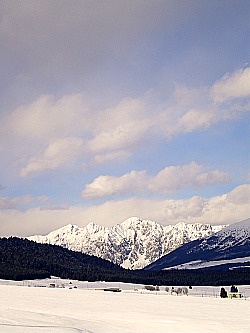
If you have been intrigued by what you’ve just read, you can find more detailed information on a page dedicated to the nature of Cansiglio.
I have also devised a page that deals specifically with the Cansiglio Botanic Garden, which gives a general introduction to the garden, while yet another page goes more in-depth, offering specific information on all the different plant habitats that can be encountered while walking not just in the garden but in the Cansiglio in general, as it is focused on its Alpine Flora.
Cansiglio’s Botanic Treasure Troves – and Beyond!
Monte Pizzoc
There are also other interesting locations to visit in the region and within easy reach from the Cansiglio's central plateau.
When considering the areas noteworthy for their flora, important sites are to be found at the edge of Cansiglio's forest, and these include Monte Pizzoc (1,565 m) and Coll’Alto (880 m); on clear days, both of these places offer outstanding views on the Venetian plains.
The first locations (Monte Pizzoc) is still within a karstic setting, and it is especially the open meadows at Cornesega that display an amazing array of flora, amongst which – in late spring – are the soft lilac clouds of Thalictrum lucidum, a showy purple Echium, a bright pink Pedicularis and many others: all plants that point to the edaphic aridity of these habitats.
In the second location (Coll’Alto), given the lower altitude, are visible plants that one would associate more with the warmer habitats of the Pre-alpine hills; one can include here the Knapweed Centaurea triunfetti, a purple-flowered Wild Lettuce (Prenanthes purpurea) and several species of Orchids.
Looking further afield, and lying outside of the central plateau, at the foothills of Cansiglio there are also other important locations worth a visit, which could easily be included within the context of a trip to the area.
Among these, one certainly has to mention the archaeological settlement by the lakes of Revine – an area carved by ice during the last glaciations, a short distance away from the pleasant historic town of Vittorio Veneto – or the beautiful location where most of the water collected from Cansiglio's main plateau drains naturally, due to the karstic nature of the terrain: the mesmerizing springs of the Livenza (Sorgenti della Livenza). Another location worth a detour are the Grotte del Caglieron – a noteworthy complex of natural and artificial caves crossed by an easy Nature trail which is literally dug into the canyon.
The Peat-bogs at Palughetto: a 14,000 Year-old Forest
The Piave Glacier
The wetlands at Palughetto have a different origin when compared to the lame (pools) present in other parts of Cansiglio: this is not the case of a sinkhole (doline), but rather a basin formed by the blocking operated by a glacier. This was a large glacier, which, about 22-20 thousand years ago, covered the Alpago region and skirted the Cansiglio plateau, depositing, right here at Palughetto, a moraine cordon that formed a small lake. This same glacier, known as Piave glacier, filled the Val Belluna, and also creared a great moraine amphitheatre south of Vittorio Veneto.
The Lake at Palughetto and its Fossil Pollen
Because of the blocking originated by the moraine, the lake did not dry up after the glacier retreated, and at its bottom deposited, year after year, clay and carbonate layers (laminated deposits), which, like the pages of a book, registered the history of the environment and climate. These 'pages' can be 'read' thanks to the fossil pollen content released by the plants that surrounded the lake, which became incorporated in the sediments. The pollen was then extracted from samples, taken from archaelogical and palaeobotanical digs. Many plants can be recognised by their pollen; for example, the fossil pollen of Larch (Larix decidua) was extracted from the sediments of the ancient lake at Palughetto, in samples that were taken during the digs. About 15,000 years ago, in the surroundings of the lake also thrived an abundant population of Scrub mountain pine (Pinus mugo), as indicated by the fossil cones and the pollen found, while tall trees were missing.
The Trees Arrive
Taller trees (Norway Spruce and Larch) reached the Palughetto about 14,000 years ago, immigrating from lower-lying areas (roughly where Vittorio Veneto and Revine are today), where they could have survived during the last glacial maximum. Soon, a sparse conifer woodland with Scrub mountain pine (Pinus mugo) formed (Phase 3). The environment was very rich, also, in herbaceous plants that today have disappeared from this area (such as Asphodelus and Alpine Flax). Evidence of both larch fossil pollen and Pinus mugo fossil cones (found during the 1997 digs) have been studied with microscopes, and dated thanks to radiocarbon.
The Peat-Bog
In those centuries, the climate modified itself quite significantly: from cold conditions, we moved on to a more temperate environment (glacial interstadium known as Bølling-Allerød). The larch and spruce forest became denser (Phase 4). Many bog plants developed in the small lake, and started to fill it with organic deposit; therefore, 14,300 years ago, the marginal areas of the lake became a peat-bog. The forest continued to develop for over 1,000 years, gaining the areas at the edge of the peat bog, where cones, leaves, branches and even trunks from bigger trees accumulated. The only broadleaved species were birch and alder. However, towards the end of the temperate interlude known as Allerød interstadial, perhaps Lime trees (linden; Tilia sp.) reached the altitude of Palughetto (about 1,040 m a.s.l.), taking part in the conifer forests, as indicated also by the charcoal used by Palaeolithic hunters, who at the time roamed the Cansiglio plateau.
The Forest Burns: the Recent Dryas
Towards 12,500 years ago, the climate became drier and colder (Recent Dryas). On the Cansiglio plateau, at that time, the forests were partly destroyed by fires (Phase 6). In fact, by studying the sediments, a strong rise in the presence of microscopic charcoal fragments was detected, flown in by the wind during the fires, and there was a subsequent rise in the pollen of herbaceous plants, which occupied new open spaces, now devoid of trees.
The Time in Which we Live (Holocene) Begins
Around 11,500 years ago the Recent Dryas terminates, and the Holocene begins: the warm temperate period in which we still live. A sinkhole located into a doline, situated to the north of Palughetto, previously obstructed by the Piave glacier, is reactivated, and the peat-bog dries out. In the surroundings, spruce forests thicken up, right at the time when Palaelolithic populations settled in the area.
An 11,500 Year Old Camp
Signalled for the first time in 1985, and inspected on several instances by the University of Ferrara between 1993 and 1997, the Palaelolithic site at Palughetto has provided interesting and precious information on the culture, and the behaviour, of the Prehistoric hunter-gatherers who lived on the Cansiglio plateau. In 1993 and 1994, two archaeological digs which took place on the abandoned moraine by the ancient Piave glacier on the northern side of the Palughetto, have retrieved hundreds of splinters and flint blades, amongst which were many instruments that were commonly used in domestic activities: the hunted animals were butchered for food; skins were also used; bones and antlers were being worked with tools, too.
A type of work that required a certain ability was the fabrication of lithic tools (that is, arrowpoints and other objects of geometric shape, which were then fixed with resin to wooden sticks, and/or bone tips): one would thus obtain hunting tools. The remains of flint production are represented by various irregular splinters and numerous fragments, besides nuclei; that is, small blocks out of which were removed the splinters and the blades by percussion, then discarded when the dimensions were too small to obtain any more. On the basis of the characteristics of these artifacts, such as type of making and shape, it was in fact possible to approximately date the camp back around 11,500 years ago.
Unfortunately, as it often happens in the outdoor archaeological sites, the traces of Pre-historic frequentation at Palughetto have been deeply dispersed and impoverished by various atmospheric and chemical agents, as well as the action of the groups of people who frequented this locality at successive times: thus, the plant and animal remains were lost, while the flint artifacts withstood a disturbance, and their original position was modified. However, it was still possible to obtain some information on the functional significance of the site, which must have been a base-camp; that is, an important reference point, reached seasonally by hunstmen and their families, and, most likely, reused over several years.
Once terminated the inspections on the moraine, a survey was carried out inside the peat bog in front of the site: in a carbon-rich layer (known as Unit T6), a few worked flint framgents have been found, similar to those found at the camp by the moraine. The archaelogical richness of Unit T6 is given, above all, by a hole intentionally dug by Palaelolithic men, inside which were placed six flint blocks, diverse for shape and dimension, as well as colour: reddish brown, yellowish brown, olive brown, grey; the dimensions vary from 65 to 132 millimetres in length; from 42 to 114 millimetres in width, with a weight comprised between 216 and 1,268 grams. The areas of provenance of these finds have been individuated on the left bank of the Piave valley (Valbelluna and Alpago), where the largest block was sourced. The shape and compactness of the blocks make them extremely apt for the production of blades. The evidence of a suitability test carried out on some of them testifies to the will to assess the material's properties right at the collection site: it implied the detachment of some splinters, or the preventative fragmentation of the block itself. Clearly, the cautious Palaelolithic hunters that roamed Cansiglio, aware of the poor flint resources of this territory, wanted to make sure to transport quality material without running up against unwanted surprises right at the moment of need.
Man and Flint: a Thousand-Year-Old Relationship
The discovery of flint deposits does not constitute a novelty for the Palaelolithic in Europe, and one can draw comparisons with similar findings in other countries such as Poland and Germany, for instance; but also with the site of Val Lastari, on nearby Sette Comuni plateau (Asiago). The Palughetto reserve can be distinguished from these other sites for the characteristics of the micro-habitat in which the finds were deposited, as the elevated humidity of the soil could have favoured the conservation -- or even bettered -- the mechanical properties of flint, suggesting a choice on the part of the group of people who settled in this precise point. By analising the settlement in its entirety, one can actually advance the hypothesis that it was the camp of an individual human group who repeatedly occupied the moraine, thanks to its raised position, and that from there they carried out their domestic activities. The peat-bog, instead, was used in two different ways: as dump, where domestic waste could be disposed of, together with the splinters and the flint instruments that were deemed no longer good for use. Besides, the deposit of tested flint, immersed in peat, makes one think of the peat's function also as storehouse for the materials to be destined for future use, perhaps for later hunting campaigns on the Cansiglio plateau, during the less cold seasons.
The evolution of the methods and techniques adopted in the production of weapons and lithic instruments has taken the Palaelolithic man to turn a growing interest towards the rocks considered -- with good reason -- as best apt to be chipped away at. The choice would normally fall on flint, as it a was a type of rock with a very thin grain, which came in different colours, formed predominantly by chalcedony and quartz, which have a concoid fracture and give out splinters with more cutting edges. The more the methods and chipping techniques were refined, the more Palaelolithic men became exigent towards the quality of raw matter, managing to procure themselves rocks even from considerable distances (up to 600 km!), with the goal of crafting reliable and durable tools. The lithic industries of the Upper Palaelolithic and the Mesolithic often show the use of a wide variety of flint types, including those of local provenance, and those repered from long distances after long journeys, or procured through bartering. From this, therefore, derives the fact that the study of abandoned flint remains in a Prehistoric camp can provide important information on the area of provenance and quality of such materials, the modalities of their finding, and the degree of knowledge of the territory in which a particular human group operated.
Sourcing Flint for the Cansiglio Settlements
As all primitive peoples in the Alps, also the first inhabitants of Cansiglio were able to find the stones that were more apt for the fabrication of tools and implements. As opposed to many other places in the Pre-Alps, the plateau only gave materials of low quality: nodules and flint from the outcrops of Grey Scale (Scaglia Grigia), whose low aptitude at being chipped forced to look for it in different locations. By turning our gaze westward towards the Dolomiti Bellunesi, we cannot help bestowing them an important role within the strategy of supplying the populations who lived in the area with lithic tools. It was, above all, towards the left-hand side of the Valbelluna -- most especially the surroundings of Mel, Trichiana and Sant'Antonio Tortal -- that people turned to for its provision of good flint, available in a wide range of calcareous, stratified types, from the so-called Biancone (a type of white limestone that contains flint nodules) to Scaglia Rossa (Red Scale). The first of these two formations is rich in large pieces of nodular, stratified flint, whose colour ranges from dark grey to black, olive brown to dark brown, and whose extremely fine grain and compactness were largely appreciated. Quite as much appreciated, were the properties of the beautiful nodular flint present in Red Scale: a calcareous formation usually poor in quality material in the rest of the Venetian Pre-Alps.
Getting closer to the Cansiglio, we then find the so-called Calcare di Soccher (another type of limestone), Grey Scale (Scaglia Grigia), Red Scale (Scaglia Rossa) and the Rosso di Col Indes, this latter one located on the southern aspect of the basin bearing the same name, bordering with the Alpago region: all these formations offerent flint of different quality, sometimes very appreciated. Reaching the Cansiglio plateau itself, we still find the Rosso di Col Indes and Grey Scale, the latter especially rich in nodular, stratified flint, usually grey or dark grey, and which could be easily sourced even at surface level. These materials were little used during the Upper Palaelolithic for the production of blades of larger size and thickness, because of the presence of a thick network of fractures that run through the rock, and favours the formation of small blocks of detritus, whose presence makes it unsuitable for the fabrication of blades of large dimensions, but it is usable instead for obtaining splinters and smaller blades. The preference towards such flint types was manifested, not by chance, during the Mesolithic, when more tools and weapons of smaller dimensions were being fabricated.
The Old Trail of the Cimbri (“Troi dei Cimbri”)
The path that is being proposed here is the fruit of a collaboration between the ‘Corpo Forestale dello Stato’ (the Italian Forestry Commission), the municipality of Fregona and the cultural association “Cimbri del Cansiglio”. This route aims to re-use paths that were habitually used – since the 1700s – by the Cimbri of Cansiglio
living in the villages of Vallorch and Le Rotte to reach the towns at
the foothill of the Cansiglio plateau, in the district of Fregona, in
order to barter their few artisan products, crafted with the beeches of
the forest. But also many inhabitants of the surrounding villages would
have made use of this trail; these were lumberjacks, woodworkers,
charcoal-makers, dairy-workers or seasonal gatherers (in this latter
case, mostly women) of woodland produce – such as mushrooms, raspberries and strawberries.
A brief description of this intense activity is provided by Antonio Caccianiga, Chief Magistrate of Treviso, who around 1867 traveled
from Fregona to Cansiglio, precisely along this trail. This is part of
his report: “We have crossed Fregona and have descended from our wagons
in Mezzavilla, where some mules were awaiting us. (…) The trail was
animated by a continuous passage of women descending from the mountain,
the back folded under wicker baskets covered in charcoal, or climbing up
to pick raspberries and strawberries in the woods. (…) We crossed the
green pastures that flanked the ‘strada remiera’ (‘route of the oars’) – so-called as it was used to transport the oars under the ancient Republic of Venice (…). We then crossed the thick of the woods and descended into the valley of Fontanaboi, where we found a spring and a shed that also serves as dwelling for a family of ‘scattolai’
(another nickname that refers to the Cimbri) (…). The interior of this
hut is composed by a kitchen that also serves as workshop and bedroom
(…). The fireplace has no chimney, and the smoke exits through the door,
the windows, and other openings in the walls and on the roof. (…) In
more modest proportions, also the charcoal-makers who exercise their
trade in various locations throughout the woodland erect similar weird
shacks. By descending towards Fontanafagher (a name that literally means ‘Beech Spring’, in the local patois), one goes along the Bear Valley (‘Valle dell’Orso’), then crosses the plains of Costa Biaver (or Costa d’Aver),
replete with the abundant red of raspberries, and by crossing over to
Le Rotte one eventually ends up on the Cansiglio plateau. (…) For now,
the proceedings of Cansiglio derive from selling firewood and timber for
woodwork; from the sleepers that are being supplied to the railways,
and the workshops of the Cimbri ‘scattolai’ that made good
sales in the nearby provinces, whose goods are being sent from Venice to
Algeria, the Jonian islands and even Alexandria of Egypt. This latter
industry was introduced by a colony of Cimbri. In 1797, four Azzalini
brothers from Rovana (a locality in the ‘Sette Comuni’ of Asiago) obtained the right to establish themselves in the woods in order to exercise their trade as ‘scattolai’.
Seventy years have gone by since their arrival in the woods, and such
was their prosperity that today there are 240 people, split into 40
families”.
Copyright © 2019 Italy-Tours-in-Nature

New! Comments
Have your say about what you just read! Leave me a comment in the box below.